Student (Equal Opportunity Center)
India is a diverse nation. It is a melting pot of various castes, religions, and civilizations. However, the Indian society is marked by a profoundly entrenched structure of class inequality. These social disparities are what gave rise to the hurdles that prevent the weaker segments of society from accessing materials, resources for culture, and educational opportunities. SCs, STs, women, OBCs (non-creamy layer), minorities, and physically challenged people are among these disadvantaged groups. The demographic data makes it quite evident that a sizable portion of the population in our nation continues to be underprivileged and disenfranchised.
SCs were compelled by a rigid, segmented caste structure to provide tasks without any expectation of compensation. Their dehumanisation and degradation were caused by the removal of their rights, identity, and dignity. The struggles and suffering of STs were similar to those of SCs. The STs were mistreated, abandoned, and left in isolation. Even now, SCs and STs both experience social impairments.
Women were viewed as inferior and unequal because of the outdated traditions and conventions of Indian society. Women continue to experience oppression today. It is crucial to eliminate these historical distortions because it is well established that gender inequality contributes to substantial social inequality.
About 19% of Indians identify as minorities like Muslims, Sikhs, Christians, Buddhists, or some other religion. The Muslim community in India demonstrates deficits and deprivation in nearly every area of development, according to the Prime Minister's High Level Committee's most recent report on the group's social, economic, and educational standing. For the other minority, the same may be true with some variations. The demographic makeup of the country should provide the physically challenged people their due respect and care. The Person with Disabilities (Equal Opportunities, Protection of Rights and Full Participation) Act 1995 was passed by Parliament to ensure the same.
When the country gained its freedom, it made a deliberate choice to right the social and historical wrongs. The Indian Constitution has a number of measures aimed at eradicating social inequalities. Our Constitution foresaw the democratic expansion of education to support social and economic upward mobility and made democratisation one of the primary goals of education.
The Indian educational system appears to have been designed solely to satisfy the needs of one-third of the populace, oblivious to the interests of the other two-thirds. Indeed, historically, access to education was very undemocratic because it was restricted to specific social groups and did exclude significant portions of the people. The disadvantaged sections in society were negatively impacted by the ever-growing gaps that were brought about by this exclusion in schooling.
The UGC has been addressing national concerns of access and equality while ensuring the standard of quality and relevance of education by implementing policies of the Government of India and promoting numerous schemes and programmes for the underprivileged groups that would help in eradicating social disparities. Higher education is a tool for social and economic equality.
India is potentially rich in human resources. To harvest the same and make the present education system inclusive, the degree of democratization of higher education has to be increased to a large extent. Further colleges should become more responsive to the needs and constraints of the disadvantaged social groups. Therefore, the UGC has planned to establish Equal Opportunity Centres in colleges.
2. Aims and Objectives
- To ensure that policies and programmes for disadvantaged groups are implemented effectively, to offer help and counselling regarding academic, financial, social, and other issues, and to increase diversity on campus
- To promote social inclusion and provide fairness and equal opportunity for the college's larger community.
- To reduce the sense of discrimination while simultaneously increasing diversity among the student, teacher, and non-teaching staff populations.
- To foster an environment where kids from different social backgrounds can connect academically and develop positive interpersonal relationships.
- To work toward raising awareness among academics of the issues related to social exclusion as well as the aspirations of the disadvantaged populations.
- To assist people or a group of pupils who are members of the underprivileged part of society in controlling the issues caused by discrimination. To investigate the issues facing the most vulnerable members of society and offer a cooperative solution to their problems.
- To communicate information regarding policies and programmes for the welfare of the socially vulnerable population, as well as official government office directives and notifications/memoranda that may occasionally be issued by related agencies or organisations.
- To develop formalities and procedures that are barrier-free for students from underprivileged groups to register and be admitted.
- To organize academic and financial resources in conjunction with the government and other agencies/organizations to support students from underprivileged groups.
- To schedule regular meetings to track the development of various plans.
- Taking steps to guarantee that SC/ST receive their fair share of admissions, hiring (for both teaching and non-teaching positions), and performance improvement.
- To educate the college about the issues of the SC/ST and other underprivileged communities.

| Grivence Redresal |



